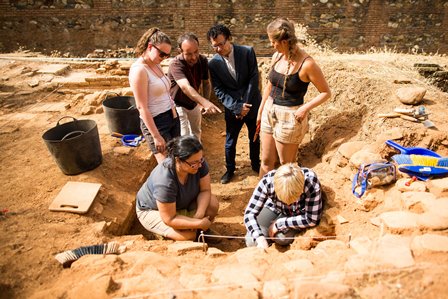The Alhambra is leading an international archaeological research project to identify the techniques used in the production of Nasrid era glass and glazed ceramics
The School of the Alhambra is leading an international archaeological research project to identify the techniques used in the production of Nasrid era glass and glazed ceramics. This initiative is the result of a collaboration agreement between the Alhambra, the University of Granada and two British universities: Bournemouth University and the University of Leicester.
More than 20 young people including archaeologists, art historians and researchers from other fields are taking part in the excavation, which is due to finish next week. This morning the Director of the Alhambra, Reynaldo Fernández Manzano accompanied this multidisciplinary team to the area known as El Secano, where the first phase of the investigation is underway: “The Alhambra continues to surprise us and we will continue to support projects of this kind, which open new fields of research and provide key data to help us expand our knowledge of the Monument”.
The archaeological excavation has already thrown up its first surprises with the discovery of the base of a keyhole kiln in the area near the Gate known as the Puerta de los Siete Suelos. They were called keyhole kilns because they had a circular hole through which the potters inserted the objects that they wanted to fire and another oblong opening into which the fuel was placed. The front of the oven has not survived, although the base remains intact.
The multidisciplinary team consists of Jesús Bermúdez, the Conservator of Archaeological Heritage of the Council of the Alhambra and Generalife; Alberto García Porras from the University of Granada; Chloe N. Duckworth (University of Leicester); Kate Welham (Boumemouth University); the coordinator David Govantes, and Derek Pitman, an expert in analysis.
During the visit to the excavation site, Alberto García Porras emphasized that the current research project combines “traditional systems with the most modern geophysical techniques which allow us to “see” beneath the surface before we begin excavating, and chemical analysis techniques that indicate the presence of the pollutants left behind by industrial activities”.
The project will be taking place in the Secano area under the title Prospection and excavation of the industrial areas of the Alhambra. Various different workshops and pottery kilns were located in this area, in which Nasrid craftsmen produced a variety of craft pieces, including glazed ceramics and carved stone, wood and metal objects that were used to decorate the Nasrid Palaces.





 Contact
Contact
















